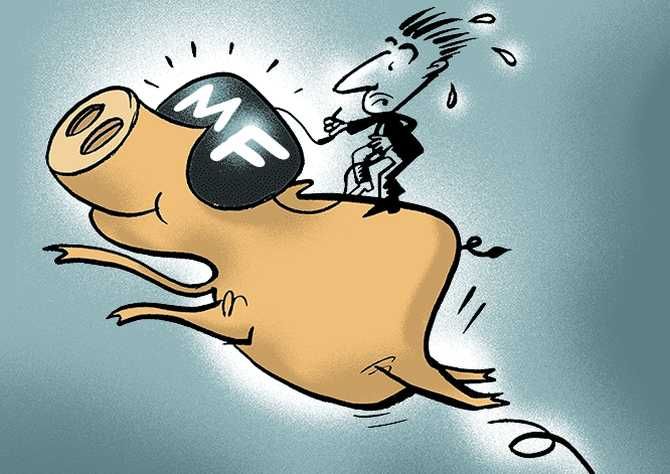It's best not to get carried away by returns or take a short-term view of the markets, says Bhavana Acharya.
Illustration: Dominic Xavier/Rediff.com

2017 turned out to be among the best years since 2009, with the equity markets clocking returns in excess of 30 per cent.
If the markets were buoyant, it could be safely concluded that mutual funds, too, had a great run. But this conclusion was put to the test in 2017.
Liquidity-driven rally
The stock markets closed both 2015 and 2016 on a sour note either on global concerns -- China's economic growth, the US elections, or Brexit -- or domestic concerns like demonetisation.
In 2017, both earnings and economic growth recovery were pushed back due to the lingering effects of currency withdrawal, disruption caused by the implementation of GST, sluggish bank lending, and lack of investment demand.
Despite all this, the Nifty 50 and the BSE Sensex rose 28 per cent during the year.
The BSE 100 index was up 31.6 per cent, the Nifty Free Float Midcap rocketed 47.4 per cent higher, and the BSE Smallcap index gained a jaw-dropping 57.4 per cent.
With no earnings and a sharp rally, valuations heated up even further.
The 2017 rally also lifted several stocks that were without strong business fundamentals and growth prospects, or were very small.
Rallies in several stocks, sectors and market segments threw valuations to the wind.
The BSE Realty index, for instance, doubled in 2017. Contrary to the market expectations, telecom stocks also rallied sharply.
Of the Nifty 500 index, nearly half of the top 100 gainers had a market capitalisation of less than Rs 30 billion.
Stock picking got harder
For equity funds, the nature of the market rally made stock picking much trickier.
Since stock picking on fundamental metrics, such as valuations, growth trajectory and its visibility for a company and its sector, business and management quality became difficult, many funds turned more cautious in 2017 than earlier.
Many stocks that rallied massively in 2017 did not, therefore, find their way into fund portfolios.
For example, of the around 80 stocks in the BSE 500 that doubled in 2017, mutual fund holdings rose in just about half.
On the whole, there was a drop in holdings in rallying sectors, such as NBFCs and fertilisers; funds have for long been underweight on performers such as FMCG.
Funds also gained weight slightly to down-and-out sectors like software and pharmaceuticals.
As a result, more funds found it hard to beat their benchmarks in 2017 than earlier.
The going was especially rough for mid-cap funds in 2017, despite the outsized gains you may have witnessed.
Barely a quarter of them managed to beat the Nifty Free Float Midcap 100 index, a departure from the turbulent years, such as 2016 and 2015, when 40 to 60 per cent of them outperformed.
Besides the explanations given above, higher allocation to large-cap stocks by some mid-cap funds also pulled their comparative returns lower.
Similarly, small-cap funds on an average underperformed the BSE Smallcap index.
Favourites DSP BlackRock Microcap and Franklin India Smaller Companies were severe underperformers.
Funds have also been lowering their small-cap exposure -- another reason for their underperformance.
With an average return of 31.2 per cent, large-cap funds, on an average, barely managed to beat the Nifty 100 index. This marginal outperformance continues from 2016.
Greater divergence in performance
In any year or any market cycle, there will always be funds that perform well and some that do not.
But a notable trend witnessed in 2017 was that divergence in fund performance within a category increased significantly.
In large-cap funds, for instance, the deviation in returns from the mean was 4.85 against 3.5 in 2015 and 2016.
In diversified funds, the deviation was 7.0 against 4.3 in the two preceding calendar years.
Fund strategy, especially against the backdrop of a tough market, had a lot to do with these deviations. A few trends were noticeable.
One, those funds that follow a more value-based approach, or turned slightly contrarian, or were cautious, saw their returns pale.
These include funds, such as ICICI Prudential Value Discovery, Franklin India Prima Plus, Franklin India Bluechip, SBI Magnum Midcap and Invesco India Mid and Small cap.
Two, some funds had higher cash holdings, either for a good part of the year or throughout the year, which again pulled down returns.
Examples include Invesco India Dynamic, ICICI Prudential Dynamic, and SBI Bluechip.
Three, funds that had a higher mid-cap share, such as IDFC Focused Equity or ICICI Prudential Multicap, managed to deliver better returns than peers that had cut back on mid-caps.
Four, a stock-specific strategy or a focussed approach, instead of a broader index-linked strategy came to the fore, given the nature of the rally.
The stock markets have not uniformly pulled up all sectors. They have been selective.
Funds such as DSP BlackRock Opportunities, Invesco India Growth, Axis Focused 25, Principal Growth, and MOSt Focused Multicap 35, which adopt a relatively stock-specific approach, all outperformed comfortably.
Key takeaways for investors
In 2017, as in the year before, market participants were hopeful that earnings and growth revival would take place. But since the recovery is still nascent, valuations have turned expensive in many stocks and sectors.
The exuberance of this market calls for caution and is a difficult one for fund managers to navigate, especially in the small- and mid-cap segment.
It is best not to get carried away by returns or take a short-term view of the markets.
Chart-toppers in any market are often there simply because they got lucky in getting into stocks, driven by market momentum and not fundamental business strength.
A fund that has proven its worth in previous markets but is underperforming now should not be a cause for worry, especially if it follows a strategy of investing in under-valued stocks or sectors.
A long-term approach, holding a mix of funds with different strategies, and following an asset-allocation approach is the best route to get around bouts of underperformance.
Bhavana Acharya is deputy head, mutual fund research, FundsIndia.com







 © 2025
© 2025